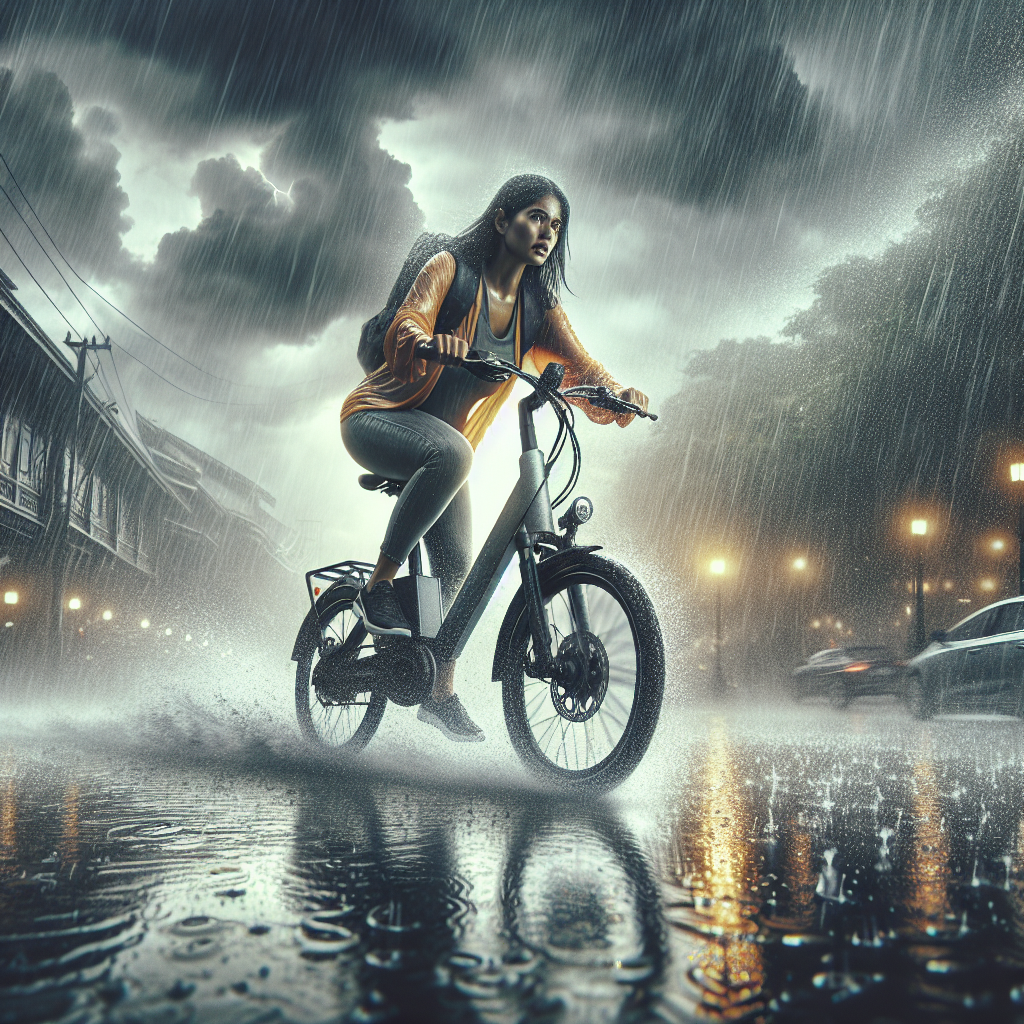Imagine the freedom of zipping through the streets on an electric bike, feeling the wind on your face and effortlessly maneuvering through traffic. But what if the rainclouds roll in? Will your e-bike be able to handle the wet conditions? The answer, my friend, is a resounding yes! Riding an e-bike in the rain is not only possible, but also quite enjoyable. In this article, we will explore why e-bikes are equipped to handle rainy weather and provide you with some essential tips to ensure a safe and comfortable ride, even on the dampest of days. So grab your raincoat and let’s explore the world of e-biking in the rain! Yes, you can ride an e-bike in the rain, but there are some potential concerns that you should be aware of. To ensure a safe and enjoyable ride in wet conditions, follow these tips and take the necessary precautions.

Slippery Road Conditions
During rainy weather, the road conditions can become slippery, which may affect your e-bike’s traction. This could lead to less control and an increased risk of accidents. To address this concern:
Decreased Traction
Keep in mind that your tires may not grip the wet road as well as they do in dry conditions. As a result, you should approach turns and corners more cautiously to avoid slipping.
Avoid Sudden Actions
To prevent skidding or sliding, try to avoid sudden acceleration, braking, or turning. Gradual movements will help maintain stability on the slippery surface.
Use Wider Tires
Consider using wider tires with a tread pattern designed for better traction on wet surfaces. These tires can provide more grip and enhance your control while riding.
Consider Lowering Tire Pressure
Lowering the tire pressure slightly can increase the contact patch between the tire and the road, resulting in improved grip. However, be mindful not to exceed the recommended pressure range for your specific tires.
Visibility
When it’s raining, visibility can be significantly reduced, making it crucial to take steps to enhance your visibility to other road users. Here are some tips:
Properly Functioning Lights
Ensure that your e-bike’s lights, including the front and rear lights, are working correctly. This will help other motorists, cyclists, and pedestrians see you, especially in low-light and rainy conditions.
Wearing Bright and Reflective Clothing
Wearing brightly colored clothing can make you more visible to others on the road. Opt for colors like yellow, orange, or fluorescent green. Additionally, consider wearing clothing with reflective elements to further increase your visibility, especially at night.
Attach Reflective Accessories
Attach reflective accessories, such as reflective tape or stickers, to your e-bike. These accessories can improve your visibility from different angles and make you more noticeable to others on the road.
Use a Clear and Anti-Fog Helmet Visor
A foggy or obscured visor can impair your visibility in rainy weather. Make sure your helmet visor is clear and consider using an anti-fog spray or wipe to prevent fogging up while riding.
Avoid Dark and Tinted Glasses
Avoid wearing dark or heavily tinted glasses in rainy conditions, as they can reduce your ability to see clearly. Instead, choose glasses with light or clear lenses to maintain optimal visibility.
Electrical Components and Water
E-bikes have electrical components that need protection from water to prevent malfunctions and potential damage. Here’s how to safeguard these components:
Water Resistance Ratings
When purchasing an e-bike, consider models with higher water resistance ratings. These ratings indicate the level of protection the e-bike has against water intrusion. Look for models with IPX4 or higher ratings, which offer good protection against splashing water.
Avoid Deep Puddles and Direct Exposure
While riding in the rain, avoid riding through deep puddles or submerging your e-bike in water. Direct exposure to a significant amount of water can damage the electrical components or affect their performance.
Dry Off the E-bike After Riding in the Rain
After your ride, take the time to dry off your e-bike thoroughly. Use a soft cloth or towel to remove any moisture from the surface, paying particular attention to the electrical components.
Protecting Connectors and Wiring
Apply silicone spray or a water-resistant dielectric grease to connectors and wiring connections. This creates a protective barrier against moisture and helps prevent corrosion or short circuits.
Battery Performance
Rainy conditions can affect the performance of your e-bike’s battery. Protecting the battery and taking specific precautions can help maintain its performance. Consider the following:
Understand the Battery’s IP Rating
Just like the e-bike itself, the battery may have an IP (Ingress Protection) rating that indicates its resistance to water and dust. Make sure you understand the battery’s rating and its recommended usage in wet conditions.
Keep Battery Connections Dry
Ensure that the battery connections remain dry during your ride. Moisture can corrode the contacts and affect the flow of electricity, potentially leading to a decrease in battery performance.
Avoid Submersion or Prolonged Exposure
Do not submerge the battery or expose it to prolonged periods of heavy rain. Water can seep into the battery casing and damage the internal components. If necessary, use a waterproof cover or bag to protect the battery.
Store the Battery in Dry Conditions
When not using your e-bike, store the battery in a dry place. Keeping it away from moisture will help maintain its performance and extend its lifespan.

Braking
Braking is a crucial aspect of riding an e-bike safely in the rain. Wet conditions can affect the braking performance, so it’s essential to adjust your techniques accordingly:
Brake Early and Gradually
Start slowing down earlier than usual when approaching a stop or turn. Gradually apply the brakes to prevent skidding or locking up the wheels due to reduced traction.
Test Brakes before a Rainy Ride
Before heading out in the rain, test your brakes to ensure they are functioning correctly. If you notice any issues such as ineffective braking or excessive squeaking, have them checked and serviced by a professional.
Dry Off Brake Pads
After riding in wet conditions, dry off the brake pads by lightly squeezing the brake lever while pedaling gently. This will help remove any water and improve the braking performance.
Consider Upgrading Brake Pads
Consider upgrading your brake pads to ones specifically designed for wet conditions. These pads have better water dispersion capabilities, providing improved braking performance in rainy weather.
Corrosion and Rust
Rainwater can accelerate the corrosion and rusting process on various parts of your e-bike. Taking proactive measures can protect your e-bike from damage and extend its lifespan:
Apply Protective Coatings
Apply a protective coating, such as wax or corrosion inhibitors, to vulnerable areas of your e-bike. This additional layer of protection helps repel water and prevent corrosion.
Regularly Clean and Dry the E-bike
Clean your e-bike regularly to remove any dirt, salt, or residue that may promote corrosion. After cleaning, make sure to dry the e-bike thoroughly to prevent the accumulation of moisture.
Lubricate Moving Parts
Apply a suitable lubricant to the moving parts of your e-bike, such as the chain, cables, and derailleur. Lubrication creates a protective barrier, preventing water from causing rust and ensuring smooth operation.
Inspect and Replace Rusty Components
Regularly inspect your e-bike for any signs of rust or corrosion. If you notice any rusty components, such as bolts, screws, or chains, it’s best to replace them as soon as possible to prevent further damage.
Choose a Suitable E-bike
Choosing the right e-bike can make a significant difference when riding in the rain. Consider the following factors when selecting an e-bike for wet weather:
Waterproof or Water-Resistant Models
Look for e-bike models that are specifically designed to be waterproof or water-resistant. These models typically have additional sealing and protection to prevent water intrusion.
Fenders and Mudguards
Opt for an e-bike that comes equipped with fenders and mudguards. These accessories help keep water, mud, and dirt off the frame, wheels, and rider, providing a more comfortable and cleaner ride.
Support for Adequate Tire Clearance
Ensure that the e-bike has sufficient tire clearance to accommodate wider tires. This feature allows you to swap to wider tires for better grip on wet surfaces, further enhancing your safety.
Consider Frame Materials
Certain frame materials, such as aluminum or carbon, are less susceptible to rust compared to steel frames. If riding in the rain frequently, consider opting for an e-bike with a frame material that offers better corrosion resistance.
Post-Ride Maintenance
After riding your e-bike in the rain, it’s crucial to perform some specific maintenance tasks to keep it in optimal condition. Here’s what you should do:
Dry Off the E-bike
After riding in wet conditions, thoroughly dry off your e-bike with a soft cloth or towel. Pay close attention to the frame, electrical components, chains, and moving parts to remove any moisture.
Clean and Lubricate the Chain
Clean the chain with a suitable degreaser to remove any dirt or debris that may have accumulated during the ride. Once clean, apply a lubricant specifically designed for wet conditions to ensure smooth and efficient operation.
Inspect Brakes and Brake Pads
Inspect the brake system for any signs of wear, damage, or misalignment. If needed, adjust or replace the brake pads to maintain optimal performance. Consult a professional if you’re unsure how to perform these tasks.
Check and Adjust Tire Pressure
After riding in the rain, it’s essential to check and adjust the tire pressure if necessary. The rain and moisture can affect tire pressure, and maintaining the recommended pressure range ensures optimal performance and safety.
By following these tips and taking the necessary precautions, you can confidently ride your e-bike in the rain without compromising your safety or the performance of your e-bike. Remember to always prioritize visibility, traction, and the protection of electrical components to ensure an enjoyable and trouble-free ride in wet conditions.

